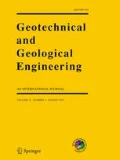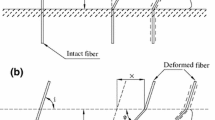Abstract
The inclusion of oriented or randomly distributed discrete elements, such as fibers, to reinforce soil has recently attracted increasing attention in geotechnical engineering. The present paper studies the shear strength parameters of reinforced sands, consisting of different mean grain sizes. The polypropylene fiber volumetric content of the sands ranges from 0.1 to 0.5 %. Specifically, a series of direct shear tests were conducted to determine the peak and residual shear strength parameters of unreinforced and reinforced sands. Laboratory results showed that fiber reinforcement substantially improved the residual strength of fine sands of medium dense state. On the contrary, reinforced sands of high dense state appeared to exhibit negligible strength increment. Based on the experimental results, a non-linear regression analysis was performed to correlate the shear strength of reinforced sand with some descriptor variables.


















Similar content being viewed by others
References
ASTM D 3080 (2005) Standard test method for direct shear test of soils under consolidated drained conditions. American Society for Testing and Materials, West Conshohocken
ASTM D 4253 (2005) Standard test methods for maximum index density and unit weight of soils using a vibratory table. American Society for Testing and Materials, West Conshohocken
ASTM D 4254 (2005) Standard test methods for minimum index density and unit weight of soils and calculation of relative density. American Society for Testing and Materials, West Conshohocken
Choubane B, Armaghani JM, Ho RK (2001) Full-Scale laboratory evaluation of polypropylene fiber reinforcement of subgrade soils. Transportation Research Board Annual Meeting, Washington Paper No 01-2157
Consoli CN, Montardo PJ, Prietto MDP, Pasa SG (2002) Engineering behaviour of a sand reinforced with plastic waste. J Geotech Geoenviron Eng 128(6):462–472
Diambra A, Ibraim E, Wood DM, Russel AR (2010) Fibre reinforced sands: experiments and modeling. Geotext Geomembr 28(3):238–250
Frost JD, Han J (1999) Behavior of interfaces between fiber-reinforced polymers and sands. J Geotech Geoenviron Eng 125(8):633–640
Gray DH, Ohashi H (1983) Mechanics of fiber reinforcement in sand. J Geotech Eng Div 109(3):335–353
Gregory GH, Chill DS (1998) Stabilization of earth slopes with fiber reinforcement. In: Proceedings of the 6th international conference on geosynthetics, Atlanta, pp 1073–1078
Ibraim E, Fourmont S (2006) Behaviour of sand reinforced with fibers. In: Proceedings of the geotechnical symposium in Roma, Netherlands, pp 807–818
Ibraim E, Diambra A, Wood MD, Russel AR (2010) Static liquefaction of fibre reinforced sand under monotonic loading. Geotext Geomembr 28(3):374–385
Jewell RA, Wroth CP (1987) Direct shear tests on reinforced sand. Geotechnique 37(1):53–68
Kaniraj SR, Havanagi VJ (2001) Behaviour of cement-stabilized fiber-reinforced fly ash-soil mixtures. J Geotech Geoenviron Eng 127(7):574–584
Latha GM, Murthy VS (2007) Effects of reinforcement form on the behaviour of geosynthetic reinforced sand. Geotext Geomembr 25(1):23–32
Lings ML, Dietz MS (2004) An improved direct shear apparatus for sand. Geotechnique 54(4):245–256
Maher MH, Gray DH (1990) Static response of sands reinforced with randomly distributed fibers. J Geotech Eng Div 116(11):1661–1677
Michalowski RL (1997) Limit stress for granular composites reinforced with continuous filaments. J Eng Mech 123(8):852–859
Michalowski RL (2008) Limit analysis with anisotropic fibre-reinforced soil. Geotechnique 58(6):489–501
Michalowski RL, Cermak J (2003) Triaxial compression of sand reinforced with fibers. J Geotech Geoenviron Eng 129(2):125–136
Michalowski RL, Zao A (1996) Failure of fiber reinforced granular soils. J Geotech Eng 122(3):226–234
Murray JJ, Frost JD, Wang Y (2000) Behaviour of a sandy silt reinforced with discontinuous recycled fiber inclusions. J Transp Res Board, No 1714, Paper No 00-1303, pp 9–17
Ozkul ZH, Gokhan B (2007) Shear behaviour of compacted rubber fiber-clay composite in drained and undrained loading. J Geotech Geoenviron Eng 133(7):767–781
Pradhan TBS, Tatsuoka F, Horii N (1988) Strength and deformation characteristics of sand in torsional simple shear. Soil Found 28(3):131–148
Pradhan PK, Kar RK, Naik A (2012) Effect of random inclusion of polypropylene fibers on strength characteristics of cohesive soil. Geotech Geol Eng 30(1):15–25
Rao SVK, Nasr AMA (2012) Laboratory study on the relative performance of silty-sand soils reinforced with linen fiber. Geotech Geol Eng 30(1):63–74
Sadek S, Najjar SS, Freiha F (2010) Shear strength of fiber-reinforced sands. J Geotech Geoenviron Eng 136(3):490–499
Shewbridge SE, Sitar N (1989) Deformation characteristic of reinforced sand in direct shear. J Geotech Eng 115(8):1134–1147
Shibuya S, Mitachi T, Tamate S (1997) Interpretation of direct shear box testing of sands as quasi-simple shear. Geotechnique 47(4):769–790
Tingle JS, Webster SL, Santoni RL (1999) Discrete fiber reinforcement of sands for expedient road construction. U.S. Army Corps of Engineers Waterways Experiment Station, Vicksburg, Report GL 99-3
Webster S, Santoni RL (1997) Contingency airfield and road construction using geosynthetic fiber stabilization of sands. U.S. Army Corps of Engineers Waterways Experiment Station, Vicksburg, Report GL 97-4
Yetimoglu T, Salbas O (2003) A study on shear strength of sands reinforced with randomly distributed discrete fibers. Geotext Geomembr 21(2):103–110
Zaimoglu AS, Yetimoglu T (2012) Strength behaviour of fine grained soil reinforced with randomly distributed polypropylene fibers. Geotech Geol Eng 30(1):197–203
Ziegler S, Leshchinky D, Ling HL, Perry EB (1998) Effect of short polymeric fibers on crack development in clays. Soil Found 38(1):247–253
Zornberg JG (2002) Discrete framework for limit equilibrium analysis of fiber reinforced soil. Geotechnique 52(8):593–604
Acknowledgments
The project is funded by the research committee of Alexander Technological Educational Institute of Thessaloniki, Greece.
Author information
Authors and Affiliations
Corresponding author
Appendix
Appendix
The derivation of Eq. 1 is based on the hypothetical case that after the addition of fibers, the total mass of solids and the volume of voids (Vv) remain unchanged. This assumption leads to the following expression:
Total mass (before) = Total mass (after)
where γs and γf are the density of solids and fibers, respectively. Vs is the initial volume of solids, V ′s is the volume of solids after the mixing (V ′s < Vs) and Vf is the volume of the fibers.
The total volume of composite is defined as:
Note that the fiber concentration by volume is ρv = Vf/Vtotal and fiber concentration by weight is ρf = Wf/Ws, where Wf and Ws are the mass of fibers and the solids, respectively.
The void ratio of the composite is:
According to the required void ratio of the composite and the fiber concentration by volume, the fiber concentration by weight can be calculated by using Eqs. (7) through (9).
Rearrangement of Eq. (7) and (8) gives:
By substituting Eqs. (10) and (11) into (9), the following is obtained:
Equation (12) can be transformed into:
Equation (13) now becomes:
Rearrangement of Eq. (14) results in the explicit expression for the fiber concentration by weight ρf.
Rights and permissions
About this article
Cite this article
Anagnostopoulos, C.A., Papaliangas, T.T., Konstantinidis, D. et al. Shear Strength of Sands Reinforced with Polypropylene Fibers. Geotech Geol Eng 31, 401–423 (2013). https://doi.org/10.1007/s10706-012-9593-3
Received:
Accepted:
Published:
Issue Date:
DOI: https://doi.org/10.1007/s10706-012-9593-3




